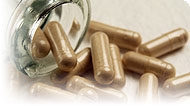Search Healthnotes
Zinc

How to Use It
Moderate intake of zinc, approximately 15 mg daily, is adequate to prevent deficiencies. Higher levels (up to 50 mg taken three times per day) are reserved for people with certain health conditions, under the supervision of a doctor. For the alleviation of cold symptoms, lozenges providing 13–25 mg of zinc in the form zinc gluconate, zinc gluconate-glycine, or zinc acetate are generally used frequently but only for several days.
Where to Find It
Possible Deficiencies
Zinc deficiencies are quite common in people living in poor countries. Phytate, a substance found in unleavened bread (pita, matzos, and some crackers) significantly reduces absorption of zinc, increasing the chance of zinc deficiency. However, phytate-induced deficiency of zinc appears to be a significant problem only for people already consuming marginally low amounts of zinc.
Even in developed countries, low-income pregnant women and pregnant teenagers are at risk for marginal zinc deficiencies. Supplementing with 25–30 mg per day improves pregnancy outcome in these groups.1, 2
People with liver cirrhosis appear to be commonly deficient in zinc.3 This deficiency may be due to cirrhosis-related zinc malabsorption.4
People with Down’s syndrome are also commonly deficient in zinc.5 Giving zinc supplements to children with Down’s syndrome has been reported to improve impaired immunity6 and thyroid function,7 though optimal intake of zinc for people with Down’s syndrome remains unclear.
Children with alopecia areata (patchy areas of hair loss) have been reported to be deficient in zinc.8, 9
The average diet frequently provides less than the Recommended Dietary Allowance for zinc, particularly in vegetarians. To what extent (if any) these small deficits in zinc intake create clinical problems remains unclear. Nonetheless, a low-potency supplement (15 mg per day) can fill in dietary gaps. Zinc deficiencies are more common in alcoholics and people with sickle cell anemia, malabsorption problems, and chronic kidney disease.10
Best Form to Take
A number of different forms of zinc are used in supplements. Zinc oxide appears to be less bioavailable than other forms, whereas zinc sulfate is not as well tolerated as other forms; therefore, forms other than zinc oxide and zinc sulfate are preferable. There is some evidence indicating that zinc picolinate has better bioavailability than other forms, although zinc citrate, zinc acetate, zinc gluconate, zinc methionine, and zinc aspartate also appear to be acceptable to use. When used in lozenges for colds, zinc acetate and zinc gluconate are the preferred forms.11
Copyright © 2025 TraceGains, Inc. All rights reserved.
Learn more about TraceGains, the company.
The information presented by TraceGains is for informational purposes only. It is based on scientific studies (human, animal, or in vitro), clinical experience, or traditional usage as cited in each article. The results reported may not necessarily occur in all individuals. Self-treatment is not recommended for life-threatening conditions that require medical treatment under a doctor's care. For many of the conditions discussed, treatment with prescription or over the counter medication is also available. Consult your doctor, practitioner, and/or pharmacist for any health problem and before using any supplements or before making any changes in prescribed medications. Information expires December 2025.











